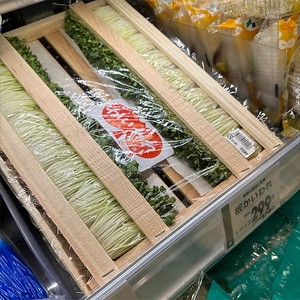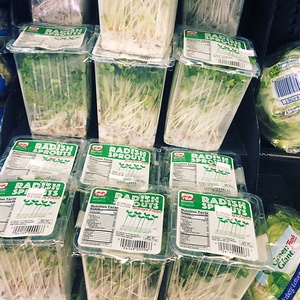


Kaiware Sprouts
Estimated Inventory, 12 ct : 3.02
This item was last sold on : 01/20/25
Description/Taste
Kaiware sprouts are small in size, comprised of thin, white to pale green stems capped with two small dark green leaves. The sprouts grow in tightly packed clusters and are generally 8 to 9 centimeters in length and 1 to 2 millimeters in diameter. The white to pale green stems are long, slender, and pliable, bearing a crisp, succulent, and slightly aqueous consistency, and the dark green leaves have a cordate, curved shape with a flat, smooth, and delicate nature. The leaves also exhibit faint veining across the surface. It is important to note that several varieties of Kaiware sprouts may appear in shades of green, red, or dark to light purple. Kaiware sprouts are often sold with their white roots intact, and the brown, round, to oval seed shells are typically found between the roots. Around the third day of sprouting, the roots may develop tiny hairs on them, which can sometimes resemble mold, but these hairs are actually a part of the sprouts and will collapse against the sprout once washed. When fresh, the sprouts release a subtle, vegetal, and peppery, radish-like scent. Kaiware sprouts have a crisp, chewy, and succulent consistency and refreshing green, grassy, and semi-sweet flavor combined with pungent, peppery notes that linger and tingle on the tongue.
Seasons/Availability
Kaiware sprouts are available year-round.
Current Facts
Kaiware sprouts, botanically classified as Raphanus sativus, are the new growth of a daikon radish plant belonging to the Brassicaceae or mustard family. The slender sprouts are sown, left to develop for 3 to 6 days, and harvested for culinary use. Kaiware sprouts were first cultivated in Japan and were highly favored for their peppery, semi-sweet, and grassy flavor. The sprouts are traditionally harvested young to retain a crisp and tender consistency and are added as a fresh garnish over a wide array of savory dishes. Kaiware sprouts can be grown year-round and have expanded in culinary popularity into Chinese, Japanese, Korean, Indian, and Southeast Asian cuisine. The sprouts have also become a specialty health food item in the United States, where they are also known as Sprouted Daikon radish, Kaiware Daikon sprouts, and Daikon radish sprouts.
Nutritional Value
Kaiware sprouts are a source of potassium to balance fluid levels and vitamin C to strengthen the immune system while reducing inflammation. The sprouts also contain lower amounts of phosphorus and calcium to protect bones and teeth, copper to develop connective tissue, magnesium to regulate nerve functions, and folate to produce red blood cells.
Applications
Kaiware sprouts have a refreshing vegetal and peppery flavor well suited for fresh preparations. The sprouts are traditionally served raw to retain their crisp, succulent consistency and are a favored edible garnish. Kaiware sprouts can be incorporated into salads, gently combined with other lettuces as a bed of greens for seafood, lightly tossed with sesame dressing as a side dish, or used as decoration for enhanced aesthetics over crab cakes, fish, roasted meats, or vegetables. The delicate sprouts can also be hand-rolled into sushi, topped over sashimi, served with soups, layered into sandwiches, used in spring rolls, or sprinkled over stir-fries for added texture. In Japan, Kaiware sprouts are often served as an accompaniment to tempura and other deep-fried dishes as a reprieve from heavier flavors. The fresh sprouts are also served with any dish where the taste of daikon radish would complement the savory ingredients. Kaiware sprouts pair well with meats including beef, pork, duck, and poultry, seafood such as fish, scallops, and crab, eggplant, carrots, mushrooms, lotus root, citrus, peanuts, and herbs such as dill, mint, thyme, and coriander. Whole, unwashed Kaiware sprouts have a short shelf life and will only keep for a couple of days when stored in the refrigerator. The sprouts should be used immediately for the best quality and flavor.
Ethnic/Cultural Info
Kaiware sprouts have been consumed in Japan since the Heian era, spanning 794 to 1185 CE, and are traditionally served fresh to savor the sprout’s tender crunch and peppery flavor. The name Kaiware translates from Japanese to mean “open shell.” The sprouts acquired this name from the small first set of leaves, also known as the cotyledon, that resembles an opened clamshell. Kaiware sprouts were initially consumed by farmers thinning their radish gardens, but over time, the delicate sprouts were gifted to nobility as a specialty item in Japan. Kaiware sprouts retained their regal reputation as farmers in Osaka began growing the sprouts in sandy plots for sale to high-end restaurants. Each seed was hand planted, and the sprouts were fast-growing, providing farmers additional income. Over time, sprout cultivation was modernized, leading the tender greens to be made commercially available to a broader demographic outside of Osaka. Kairware sprouts are common in Japan in the modern-day. Historically, the term Kaiware was used to describe only the sprouts of daikon radishes as it was the first type of sprout to reach substantial popularity in Japan, but the term has become looser, sometimes used to describe any type of sprout grown for culinary use.
Geography/History
Kaiware sprouts are young versions of daikon radishes, which experts believe to be native to the Mediterranean and coastal regions along the Black Sea. The mild roots were introduced to Asia through trade routes in ancient times, and the radishes arrived in Japan sometime during the Heian era. Daikon radishes were mentioned in Japanese texts in the 10th and 11th centuries and became widely cultivated throughout Japan during the Edo period. For many years, the young daikon radish sprouts were reserved for high-end restaurants, but in the 1980s, Japanese farmers modernized sprout cultivation using large-scale hydroponic growing systems, allowing the sprouts to be produced in larger quantities. Kaiware sprouts expanded in popularity across Japan in the late 20th century, and in 2005, the Japan Sprouts Association, formerly known as the Japan Kaiware Association, was established to regulate the booming business and ensure safety measures were being met in cultivation. Today Kaiware sprouts are prevalent across Japan and are also grown and sold through companies worldwide. The sprouts are commonly sold in clamshells or small clumps with their roots still intact through health food stores, farmer’s markets, and specialty distributors. Kaiware sprouts are also grown in home kitchens, but it is important to source the seeds from a seed company that offers sprout seeds to avoid contaminated seeds that could lead to poisoning.
Featured Restaurants
Restaurants currently purchasing this product as an ingredient for their menu.
| La Jolla Country Club | San Diego CA | 858-454-9601 |
| Nobu | San Diego CA | 619-814-4124 |
| Common Theory | San Diego CA | 858-384-7974 |
| Himitsu | La Jolla CA | 858-345-0220 |
| Hotel La Jolla - Sea & Sky | La Jolla CA | 858-459-0261 |
| Fish & Things Poke Bar | San Diego CA | 916-995-1555 |
| Sheraton Carlsbad (Banquets) | Carlsbad CA | 760-827-2400 |
| KI's | Encinitas CA | 760-586-8289 |
| The Joint | San Diego CA | 619-222-8272 |
| Under Belly-Little Italy Kitchen | San Diego CA | 619-269-4626 |
| Cocina de Barrio Point Loma | San Diego CA | 858-349-2313 |
| Boujiemana (TCW) | San Diego CA | 415-710-0510 |
| Ju-Ichi | San Diego CA | 619-800-2203 |
| Pacific Yacht Agents | Los Angeles CA | 808-214-0970 |
| Fishery | San Diego CA | 858-272-9985 |
| Under Belly-Uptown | San Diego CA | 619-269-4626 |
| Brockton Villa Restaurant | San Diego CA | 858-454-7393 |
| Lafayette Hotel - Lou Lou's | San Diego CA | 619-296-2101 |
| Bica | San Diego CA | 619-669-5725 |
| Sushi Freak-Middle Town | San Diego CA | 619-296-2500 |
| Pacific Coast Grill | Solana Beach CA | 858-794-4632 |
| Bang on 5th | San Diego CA | 619-677-5650 |
| Cocina de Barrio Encinitas | Encinitas CA | 760-840-1129 |
| Dija Mara | Oceanside CA | 760-231-5376 |
| The Bowl | San Diego CA | 619-813-5865 |
| Pamplemousse Grill | Solana Beach CA | 858-792-9090 |
| Madison | San Diego CA | 619-822-3465 |
| Compa Coffee Roasters | San Diego CA | 858-205-8048 |
| Harney Sushi | San Diego CA | 619-295-3272 |
| Trust Restaurant | San Diego CA | 609-780-7572 |
| La Jolla Beach & Tennis Club | San Diego CA | 619-816-8319 |
| Coast Catering | Escondido CA | 619-295-3173 |
| Sushi Nekosan | La Jolla CA | 858-999-0999 |
| Park Commons - ARE | San Diego CA | 619-295-3172 |
| Ron Oliver | San Diego | 619-295-3172 |
| Animae | San Diego CA | 619-925-7908 |
| HiroNori Ramen | San Diego CA | 619-446-9876 |
Recipe Ideas
Recipes that include Kaiware Sprouts. One
| Gourmet Sleuth |
|
Blackened Ahi with Soy Mustard Sauce |
| Gourmet Sleuth |
|
Spicy Tuna Tartare |










